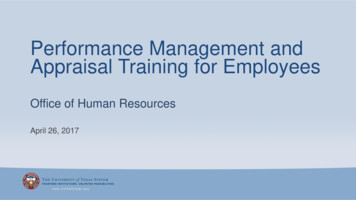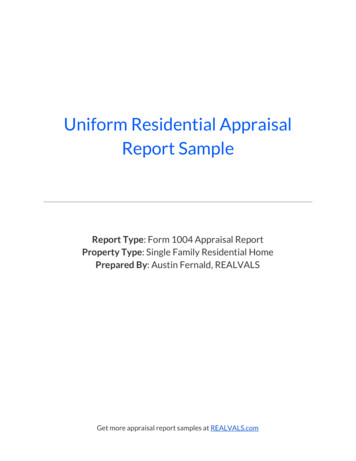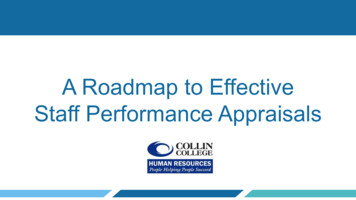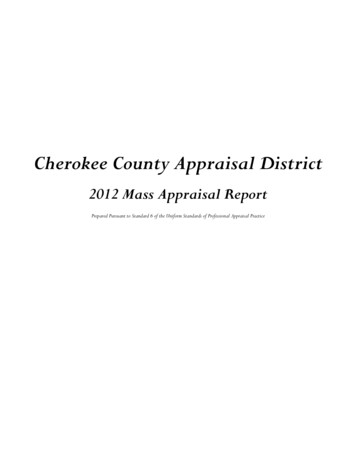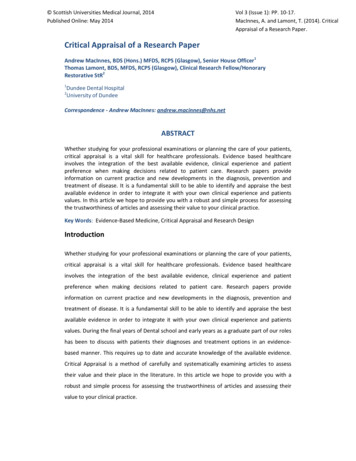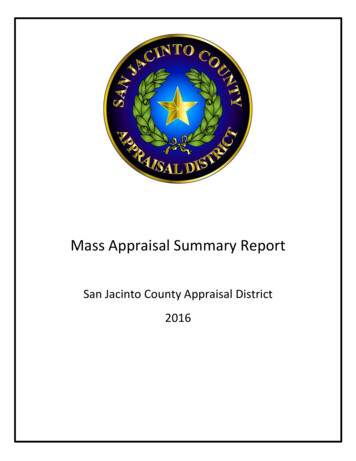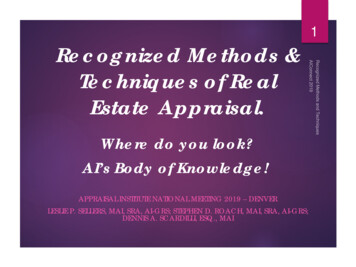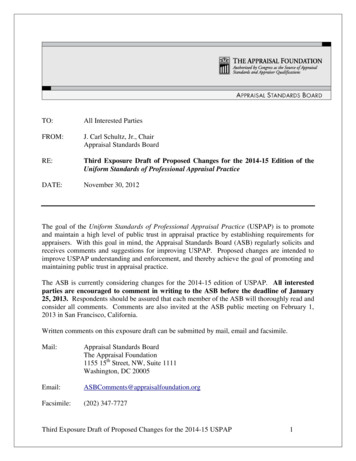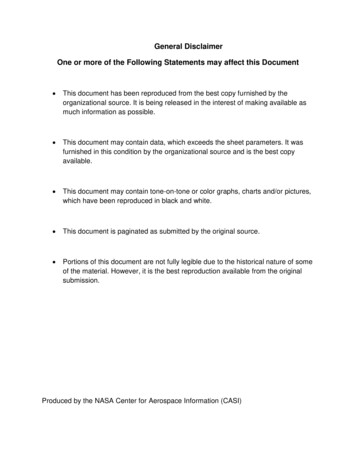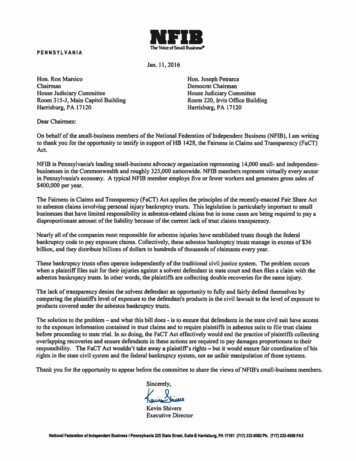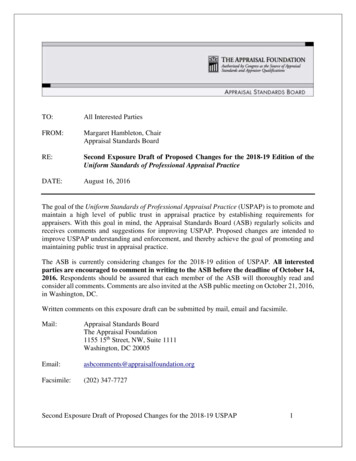
Transcription
TO:All Interested PartiesFROM:Margaret Hambleton, ChairAppraisal Standards BoardRE:Second Exposure Draft of Proposed Changes for the 2018-19 Edition of theUniform Standards of Professional Appraisal PracticeDATE:August 16, 2016The goal of the Uniform Standards of Professional Appraisal Practice (USPAP) is to promote andmaintain a high level of public trust in appraisal practice by establishing requirements forappraisers. With this goal in mind, the Appraisal Standards Board (ASB) regularly solicits andreceives comments and suggestions for improving USPAP. Proposed changes are intended toimprove USPAP understanding and enforcement, and thereby achieve the goal of promoting andmaintaining public trust in appraisal practice.The ASB is currently considering changes for the 2018-19 edition of USPAP. All interestedparties are encouraged to comment in writing to the ASB before the deadline of October 14,2016. Respondents should be assured that each member of the ASB will thoroughly read andconsider all comments. Comments are also invited at the ASB public meeting on October 21, 2016,in Washington, DC.Written comments on this exposure draft can be submitted by mail, email and facsimile.Mail:Appraisal Standards BoardThe Appraisal Foundation1155 15th Street, NW, Suite 1111Washington, DC imile:(202) 347-7727Second Exposure Draft of Proposed Changes for the 2018-19 USPAP1
IMPORTANT NOTE: All written comments will be posted for public viewing, exactly assubmitted, on the website of The Appraisal Foundation. Names may be redacted uponrequest.The Appraisal Foundation reserves the right not to post written comments that containoffensive or inappropriate statements.If you have any questions regarding the attached exposure draft, please contact Aida Dedajic,Standards Administrator at The Appraisal Foundation, via e-mail at aida@appraisalfoundation.orgor by calling (202) 624-3058.BackgroundOn April 13, 2016, the ASB issued the First Exposure Draft of proposed changes for the 2018-19edition of USPAP. That exposure draft addressed: Definition of reportDefinition of assignmentExtraordinary assumptionSTANDARD 3, Appraisal Review, Development and ReportingSTANDARD 6 – Dividing into STANDARD 5, Mass Appraisal, Development andSTANDARD 6, Mass Appraisal, ReportingStandards Rules 7-2(c), SR 7-5, and 8-2(v)Standards Rule 8-3Advisory Opinion 37, Computer Assisted Valuation ToolsThe ASB has reviewed all of the comments received in response to the First Exposure Draft, andbelieves it is fulfilling its work plan and addressing the needs of appraisers and users of appraisalservices by incorporating that feedback into the changes proposed for the 2018-19 edition ofUSPAP as contained in this Second Exposure Draft.Of paramount importance to the Board when considering any potential revisions to USPAP is theissue of public trust. This umbrella of public trust, therefore, remains the primary considerationof the ASB in putting forth the concepts contained in this document.The Board currently intends to adopt any revisions for the 2018-19 edition of USPAP at its publicmeeting in early 2017. Any such revisions to USPAP would become effective on January 1, 2018.Second Exposure Draft of Proposed Changes for the 2018-19 USPAP2
Executive SummarySecond Exposure Draft of Proposed Changes for the 2018-19 USPAPTo assist readers of this exposure draft, this Executive Summary is intended to be a brief discussionof each section in the document. Because some readers may not have a specific interest in everysection of the document, this Executive Summary will allow readers to direct their focus on theirspecific interest(s).For detailed information on proposed revisions and the reasons for the proposals, we stronglyencourage readers to thoroughly review the rationale for each section, along with the specificchanges being proposed. After doing so, we respectfully request readers to submit any relevantcomments.Section 1 – Definition of Report and Edits to the ETHICS RULE and the RECORDKEEPING RULEThe ASB is attempting to resolve issues related to the definition of report being tied to completionof the assignment. The Board is also attempting to clarify requirements for communicatingassignment results outside the parameters of a report, by proposing revisions to the Conduct sectionof the ETHICS RULE. The Board is also proposing revisions to the RECORD KEEPING RULEto address an appraiser’s obligations to maintain such communications. The Board is proposinglanguage to make it clearer that the workfile must be sufficient for the appraiser to produce anAppraisal Report or an Appraisal Review Report.Section 2 – Definitions of Assignment, Intended Use, and Intended User, and related edits tothe COMPETENCY RULEThe Board is proposing revising the definition of assignment to remove the portion of the definitioninvolving the agreement to provide services. The Board is also proposing clarifying the definitionsof intended use and intended user by substituting “during the assignment” for the current language,“at the time of assignment.” Lastly, the Board is proposing revisions to the COMPETENCY RULEto address the appraiser’s obligations prior to accepting an assignment.Section 3 – Definitions of Assumption and Extraordinary AssumptionThe Board is proposing retention of the terms assumption and extraordinary assumption, but isproposing revisions to the definitions.Section 4 – STANDARD 3 – Dividing into STANDARD 3, Appraisal Review, Developmentand STANDARD 4, Appraisal Review, ReportingThe Board is proposing revising the definition of appraisal review, as well as dividing the existingSTANDARD 3 into two standards, for greater consistency with the other standards in USPAP.Section 5 – STANDARD 6 – Dividing into STANDARD 5, Mass Appraisal, Development andSTANDARD 6, Mass Appraisal, ReportingSecond Exposure Draft of Proposed Changes for the 2018-19 USPAP3
The Board is proposing revisions to the existing STANDARD 6, including dividing it into twostandards for improved consistency in USPAP. The Board is also proposing changes to the currentmass appraisal reporting standard to reflect changes previously made to the other reportingstandards when the Self-Contained Appraisal Report option was eliminated.Section 6 – Removing the term Market Value from STANDARDS 7 and 8The Board is proposing removing the term market value from the personal property developmentand reporting standards, as the expression Market Value is seldom used in this discipline. If theproposed revisions are ultimately adopted, when necessary for credible results, these proposedchanges may result in additional analyses and reporting requirements for the personal propertyappraiser.Section 7 – Edits to the Personal Property Certification in Standards Rule 8-3The Board is proposing changes to allow personal property appraisers, in assignments involvingdifferent types of items, to sign the certification without making them accountable for theassignment results of items which they did not appraise.Section 8 – Advisory Opinion 37, Computer Assisted Valuation ToolsThe Board is proposing a new advisory opinion addressing technology-based tools commonly usedin the appraisal profession. The Board is also considering whether or not an update of AdvisoryOpinion 18, Use of an Automated Model (AVM), is necessary, or whether AO-18 should be retired.Section 9 – Illustration in Advisory Opinion 21, USPAP ComplianceThe Board is proposing a revision to the graphics depicted in AO-21, to more clearly illustrate therelationship between appraisal practice and valuation services.Section 10 – Edits to Advisory Opinion 31, Assignments Involving More than One AppraiserThe Board is proposing edits to AO-31 to help clarify guidance related to significant appraisalassistance.Section 11 - Edits to Advisory Opinion 1, Sales HistoryThe Board is proposing edits to AO-1 to help clarify guidance related to an appraiser’s properanalysis and reporting related to a subject property’s prior and pending sales and current listings.Second Exposure Draft of Proposed Changes for the 2018-19 USPAP4
Second Exposure Draft of Proposed Changes for the2018-19 edition of the Uniform Standards of Professional Appraisal PracticeIssued: August 16, 2016Comment Deadline: October 14, 2016Each section of this exposure draft begins with a rationale for the proposed changes to USPAP.The rationale is identified as such and does not have line numbering. Where proposed changes toUSPAP are noted, the exposure draft contains line numbers. This difference is intended todistinguish for the reader those parts that explain the changes to USPAP from the proposed changesthemselves.When commenting on various aspects of the exposure draft, it is very helpful to reference the linenumbers, fully explain the reasons for concern or support, provide examples or illustrations, andsuggest any alternatives or additional issues that the ASB should consider.Unless otherwise noted, where text is proposed to be deleted from USPAP, that text is shown asstrikethrough. For example: This is strikethrough text proposed for deletion. Text that is proposedto be added to USPAP is underscored. For example: This is text proposed for insertion.This exposure draft includes proposed revisions to USPAP and creation of a new AdvisoryOpinion. After considering the responses received during the exposure period the ASB willdeliberate over the various proposals. The Board intends to issue a Third Exposure Draft later thisyear.For ease in identifying the various issues being addressed, the exposure draft is presented insections.NOTE: Footnotes are not shown in the proposed revisions presented in this document. Anyrevisions adopted to USPAP will incorporate updates to applicable footnotes in the 2018-19USPAP publication.If the proposed revisions are adopted, it will necessitate administrative edits throughout USPAP.Second Exposure Draft of Proposed Changes for the 2018-19 USPAP5
TABLE OF CONTENTSSectionIssuePage1Definition of Report and Edits to the ETHICS RULE and theRECORD KEEPING RULE72Definitions of Assignment, Intended Use, and Intended User, andrelated edits to the COMPETENCY RULE123Definitions of Assumption and Extraordinary Assumption144STANDARD 3 – Dividing into STANDARD 3, Appraisal Review,Development and STANDARD 4, Appraisal Review, Reporting155STANDARD 6 – Dividing into STANDARD 5, Mass Appraisal,Development and STANDARD 6, Mass Appraisal, Reporting266Removing the term Market Value from STANDARDS 7 and 8417Edits to the Personal Property Certification in Standards Rule 8-3508Advisory Opinion 37, Computer Assisted Valuation Tools539Illustration in Advisory Opinion 21, USPAP Compliance6110Edits to Advisory Opinion 31, Assignments Involving More than OneAppraiser6511Edits to Advisory Opinion 1, Sales History72Second Exposure Draft of Proposed Changes for the 2018-19 USPAP6
Section 1:Definition of Report and Edits to the ETHICS RULE and the RECORDKEEPING RULERATIONALEThe ASB has heard concerns about the definition of report for some time. Enforcement officialsand others have voiced concerns about appraisers who issue multiple documents (some with asigned certification) in an assignment and then attempt to disavow responsibility for prior iterationsbecause they were not transmitted “upon completion of the assignment” as specified in the currentUSPAP definition of report. This claim has been made even in cases where the earlier version wassubmitted as a report with a signed certification and later revised.The determining factor in the current definition of report in USPAP is “upon completion of theassignment.” Given that definition, any communication transmitted to the client prior tocompletion of the assignment is not a report. If a communication, intended to be a report, issuperseded by a subsequent document, then by the current definition, the first document was not areport (because it was not transmitted upon completion of the assignment).When an assignment is complete depends on various factors and upon the perspective of a givenparty. Appraisers usually consider an assignment complete when they sign or communicate thereport to the client, whereas clients have commented that an assignment is not complete until theyreview and approve or accept a report. In studying the overall concept of reporting, the ASBconcluded that it is important to address all communications of assignment results regardless ofwhere an appraiser is in the process.The ASB has received many comments that emphasized the importance of preliminarycommunications in complex assignments. These comments came from appraisers in all disciplines.USPAP does not currently address communications of assignment results prior to completion ofthe assignment, thus such communications have no requirements other than to comply with thegeneral requirements in the ETHICS RULE, the COMPETENCY RULE, and theJURISDICTIONAL EXCEPTION RULE. The RECORD KEEPING RULE requires retention ofall reports; however, anything transmitted prior to completion of the assignment is not a report.The ASB is proposing linking the definition of a report to when the report is communicated witha signed certification. By signing a certification, the appraiser is representing to the client that thedocument is a report. With the proposed revisions to the definition, any communication of a portionof an appraiser’s opinions or analyses performed as part of an appraisal or appraisal reviewassignment is not a report, thus not subject to reporting Standards, unless it includes a signedcertification. However, when communicating portions of opinions or analyses performed as partof an assignment, the appraiser would still be required to comply with the ETHICS RULE, theCOMPETENCY RULE and the JURISDICTIONAL EXCEPTION RULE.A number of stakeholders have expressed concern that this proposal could result in an increasednumber of clients requesting a draft prior to the appraiser submitting the final report. Over theyears there have been reports of mortgage lenders using their appraiser’s preliminary findings inSecond Exposure Draft of Proposed Changes for the 2018-19 USPAP7
order to shop for an appraisal that will allow them to make their loan. This act is expresslyprohibited by federal lending laws and its enforcement is outside the purview of the ASB.The changes now proposed by the ASB would place an obligation on appraisers to make it clearthat the document they are submitting is not a report, but rather a preliminary document. If a clientrelies upon one of these preliminary documents, the document communicated to the client and thecopy in the workfile would be clearly marked as being preliminary in nature and subject to change.Currently, USPAP does not specifically require that preliminary communications be retained. Thisdecision is left to the discretion of the appraiser or applicable laws, regulations, or requirements ofprofessional appraisal organizations. The ASB received stakeholder input from some associationsand jurisdictions indicating that they have set requirements with regard to preliminarycommunications and document retention. As with all services an appraiser provides, it is theappraiser's responsibility to be aware of and comply with all applicable standards, guidelines, andrequirements in addition to those required by USPAP. This exposure draft also includes a proposedaddition to the RECORD KEEPING RULE that would require retention of a copy of anycommunication of assignment results unless and until it is superseded.In order to maintain public trust, the ASB is also proposing that all communications of preliminaryassignment results be clearly identified as such (e.g., draft, preliminary, subject to change, etc.); todo otherwise could be misleading. A change proposed to the Conduct section of the ETHICSRULE specifically addresses this.In addition, there is a proposed edit to the RECORD KEEPING RULE regarding the workfilecontent that is required in support of an oral report. Like any other appraisal or appraisal reviewassignment, an assignment with an oral report requires a scope of work that is sufficient to producecredible assignment results. Currently, there is a requirement that the workfile for a RestrictedAppraisal Report be sufficient to produce an Appraisal Report. The proposed edit clarifies that anoral report’s additional workfile requirements (i.e., summaries of oral reports or testimony or atranscript of testimony and the certification) are not a substitute for the requirement to include “allother data, information, and documentation necessary to support the appraiser’s opinions andconclusions and to show compliance with USPAP.” The ASB proposes to make it a clearrequirement that the workfile for an oral report, which per the Standards Rules must address thesubstantive matters covered in an Appraisal Report or Appraisal Review Report, is consistent withthat of a Restricted Appraisal Report. This edit also includes a minor formatting change.DEFINITIONS12345REPORT: any written communication, written or oral, of an appraisal or appraisal review that istransmitted with a signed certification to the client or a party authorized by the client; uponcompletion of an assignment or any oral communication of an appraisal or appraisal review that istransmitted to the client or a party authorized by the client in an assignment for which a writtenreport is not transmitted.Second Exposure Draft of Proposed Changes for the 2018-19 USPAP8
678Comment: Most reports are written and most clients mandate written reports. Oralreport requirements (see the RECORD KEEPING RULE) are included to covercourt testimony and other oral communications of an appraisal or appraisal review.ETHICS RULE9Conduct:1011An appraiser must perform assignments with impartiality, objectivity, and independence,and without accommodation of personal interests.12An appraiser:13 must not perform an assignment with bias;14 must not advocate the cause or interest of any party or issue;1516 must not accept an assignment that includes the reporting of predetermined opinionsand conclusions;1718 must not misrepresent his or her role when providing valuation services that areoutside of appraisal practice;19 must not communicate assignment results with the intent to mislead or to defraud;2021 must not use or communicate a report or assignment results known by the appraiserto be misleading or fraudulent;2223 must not knowingly permit an employee or other person to communicate a report orassignment results that are misleading or fraudulent report;242526 must not communicate all or any portion of assignment results, except in a report,without clearly and conspicuously disclosing that the communication is preliminary(e.g., draft, preliminary, subject to change, etc.);27282930 must not use or rely on unsupported conclusions relating to characteristics such asrace, color, religion, national origin, gender, marital status, familial status, age,receipt of public assistance income, handicap, or an unsupported conclusion thathomogeneity of such characteristics is necessary to maximize value;31 must not engage in criminal conduct;3233 must not willfully or knowingly violate the requirements of the RECORD KEEPINGRULE; and34 must not perform an assignment in a grossly negligent manner.Second Exposure Draft of Proposed Changes for the 2018-19 USPAP9
3536373839Comment: Development standards (1-1, 3-1, 6-1, 7-1 and 9-1) address therequirement that “an appraiser must not render appraisal services in a careless ornegligent manner.” The above requirement deals with an appraiser being grosslynegligent in performing an assignment which would be a violation of the Conductsection of the ETHICS RULE.404142If known prior to accepting an assignment, and/or if discovered at any time during theassignment, an appraiser must disclose to the client, and in each subsequent reportcertification:4344 any current or prospective interest in the subject property or parties involved;and454647 any services regarding the subject property performed by the appraiser within thethree-year period immediately preceding acceptance of the assignment, as anappraiser or in any other capacity.4849505152Comment: Disclosing the fact that the appraiser has previously appraised the property ispermitted except in the case when an appraiser has agreed with the client to keep the mereoccurrence of a prior assignment confidential. If an appraiser has agreed with a client notto disclose that he or she has appraised a property, the appraiser must decline all subsequentassignments that fall within the three-year period.RECORD KEEPING RULE53545556An appraiser must prepare a workfile for each appraisal or appraisal review assignment. Aworkfile must be in existence prior to the issuance of any report or other communication ofassignment results. A written summary of an oral report must be added to the workfilewithin a reasonable time after the issuance of the oral report.57The workfile must include:58 the name of the client and the identity, by name or type, of any other intended users;596061 true copies of all written reports, documented on any type of media. (A true copy isa replica of the report transmitted to the client. A photocopy or an electronic copy ofthe entire report transmitted to the client satisfies the requirement of a true copy.);6263 summaries of all oral reports or testimony, or a transcript of testimony, including theappraiser’s signed and dated certification;646566 all other data, information, and documentation necessary to support the appraiser’sopinions and conclusions and to show compliance with USPAP, or references to thelocation(s) of such other data, information, and documentation; and6768 true copies of all preliminary communications of assignment results transmitted toclients or parties authorized by the client, documented on any type of media, unlessSecond Exposure Draft of Proposed Changes for the 2018-19 USPAP10
69707172and until such communication is superseded by a subsequent communication orreport. a workfile in support of a Restricted Appraisal Report must be sufficient for theappraiser to produce an Appraisal Report.73747576A workfile in support of a Restricted Appraisal Report or an oral appraisal report must besufficient for the appraiser to produce an Appraisal Report. A workfile in support of an oralappraisal review report must be sufficient for the appraiser to produce an Appraisal ReviewReport.777879An appraiser must retain the workfile for a period of at least five years after preparation orat least two years after final disposition of any judicial proceeding in which the appraiserprovided testimony related to the assignment, whichever period expires last.80818283An appraiser must have custody of the workfile, or make appropriate workfile retention,access, and retrieval arrangements with the party having custody of the workfile. Thisincludes ensuring that a workfile is stored in a medium that is retrievable by the appraiserthroughout the prescribed record retention period.8485An appraiser having custody of a workfile must allow other appraisers with workfileobligations related to an assignment appropriate access and retrieval for the purpose of:86 submission to state appraiser regulatory agencies;87 compliance with due process of law;88 submission to a duly authorized professional peer review committee; or89 compliance with retrieval arrangements.9091Comment: A workfile must be made available by the appraiser when required by a stateappraiser regulatory agency or due process of law.9293An appraiser who willfully or knowingly fails to comply with the obligations of thisRECORD KEEPING RULE is in violation of the ETHICS RULE.Second Exposure Draft of Proposed Changes for the 2018-19 USPAP11
Section 2:Definitions of Assignment, Intended Use, and Intended User, and related editsto the COMPETENCY RULERATIONALEThe USPAP definitions of intended use and intended user include the phrase, “on the basis ofcommunication with the client at the time of the assignment.” Because the USPAP definition ofassignment includes both: (1) the agreement; and (2) the valuation service, there have been manyquestions about the timeframe referred to by “at the time of the assignment.”This is important because appraisers cite USPAP in support of differing opinions about what mustbe done in the event of changes during a valuation service. For some, the USPAP definitions ofintended use and intended user seem to prohibit changes after a specific point in the appraisalprocess. Others believe that the SCOPE OF WORK RULE permits the appraiser flexibility in howto respond to new information. One of the reasons for the differing interpretations is confusionabout whether “at the time of the assignment” means the time of the agreement or the period oftime during which the valuation service is being performed.To clarify, the ASB is proposing to revise the USPAP definition of assignment so that the termwill refer only to the valuation service.A modification to the USPAP definitions of intended use and intended user is also being proposedfor clarity and consistency.In addition, the ASB is proposing different wording for the phrase, “at the time of the assignment,”where it occurs in the Being Competent section of the COMPETENCY RULE.These proposed changes would confirm that the appraiser has flexibility to modify the scope ofwork based upon information or conditions discovered during a valuation service. The SCOPE OFWORK RULE states, in part: “Information or conditions discovered during the course of anassignment might cause the appraiser to reconsider the scope of work.” Advisory Opinion 36,Identification and Disclosure of Client, Intended Use, and Intended Users, offers more detail, asfollows: “If, during the assignment, an appraiser becomes aware of a change in the intended use,the appraiser must consider whether the extent of the development process and report contentinitially planned are still appropriate. If they are not, the appraiser must make the necessarychanges.” USPAP does not prescribe business practices and does not specify the timeframe whenchanges may be made. USPAP neither requires nor prohibits an appraiser from changing orrenegotiating an agreement if a client makes changes to assignment elements after the appraiserhas begun work. What USPAP does require is the appraiser take responsibility to ensure that thescope of work for each assignment is sufficient to produce credible assignment results.If these changes to USPAP are adopted, other minor edits for the purpose of clarity may be madeto USPAP, the Advisory Opinions and Frequently Asked Questions prior to publication of the nextedition.Second Exposure Draft of Proposed Changes for the 2018-19 USPAP12
DEFINITIONS949596ASSIGNMENT: 1) An agreement between an appraiser and a client to provide a valuationservice; 2) the a valuation service that is provided by an appraiser as a consequence of anagreement with a client such an agreement.979899100101INTENDED USE: the use or uses of an appraiser’s reported appraisal or appraisal reviewassignment opinions and conclusions, as identified by the appraiser based on communication withthe client at the time of the assignment the use or uses, as identified by the appraiser based oncommunication with the client during the assignment, of the reported appraisal or appraisal reviewassignment results.102103104INTENDED USER: the client and any other party as identified, by name or type, as users of theappraisal or appraisal review report by the appraiser based on the basis of communication with theclient at the time of during the assignment.COMPETENCY RULE105Being Competent106107108Prior to agreeing to perform an assignment, anThe appraiser must determine, prior toaccepting an assignment, that he or she can perform the assignment competently.Competency requires:1091101111121. the ability to properly identify the problem to be addressed;2. the knowledge and experience to complete the assignment competently; and3. recognition of, and compliance with, laws and regulations that apply to theappraiser or to the assignment.113114115116117118Comment: Competency may apply to factors such as, but not limited to, an appraiser’sfamiliarity with a specific type of property or asset, a market, a geographic area, anintended use, specific laws and regulations, or an analytical method. If such a factor isnecessary for an appraiser to develop credible assignment results, the appraiser isresponsible for having the competency to address that factor or for following the stepsoutlined below to satisfy this COMPETENCY RULE.119120121For assignments with retrospective opinions and conclusions, the appraiser must meetthe requirements of this COMPETENCY RULE at the time of the assignment isperformed, rather than the effective date.Second Exposure Draft of Proposed Changes for the 2018-19 USPAP13
Section 3:Definitions of Assumption and Extraordinary AssumptionRATIONALE:After receiving comments from stakeholders about difficulties in understanding and explaining theterm, extraordinary assumption, the ASB explored the idea of replacing the term and refining itsdefinition. It was also suggested that the ASB review the term and definition of assumption to helpdistinguish common, ordinary assignment conditions from those, which require clear andconspicuous disclosure. However, many comments in response to the First Exposure Draftindicated that clarifications of the definitions would be more helpful than introducing newterminology. The ASB is therefore proposing the following revisions to the DEFINITIONSwithout changing the terms themselves.An extraordinary assumption requires the appraiser to give clear and cautionary notice to the clientand other intended users because of a significant element of uncertainty in the appraiser’s opini
Second Exposure Draft of Proposed Changes for the 2018-19 USPAP 5 Second Exposure Draft of Proposed Changes for the 2018-19 edition of the Uniform Standards of Professional Appraisal Practice Issued: August 16, 2016 Comment Deadline: October 14, 2016 Each section of this exposure draft begins with a rati
